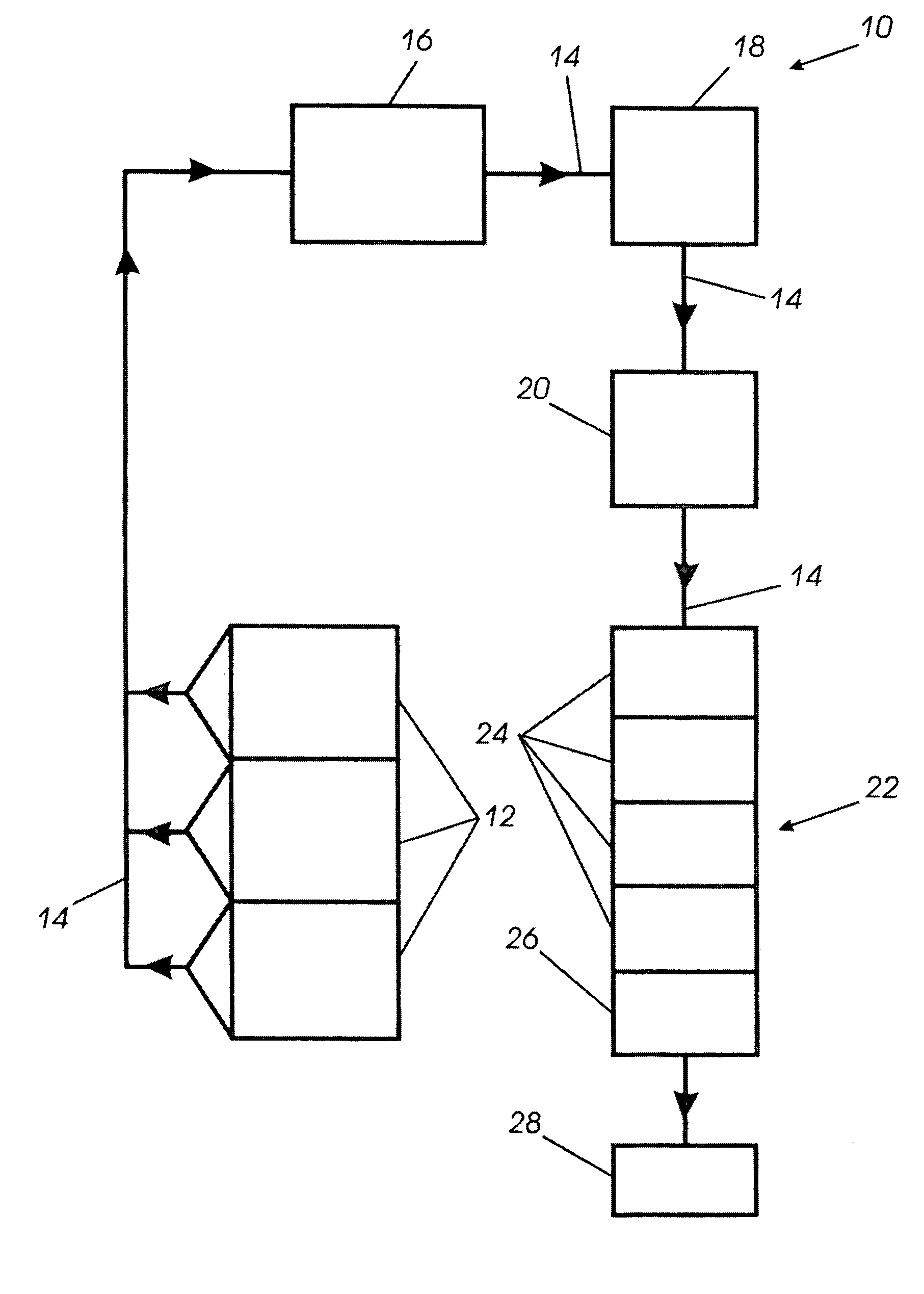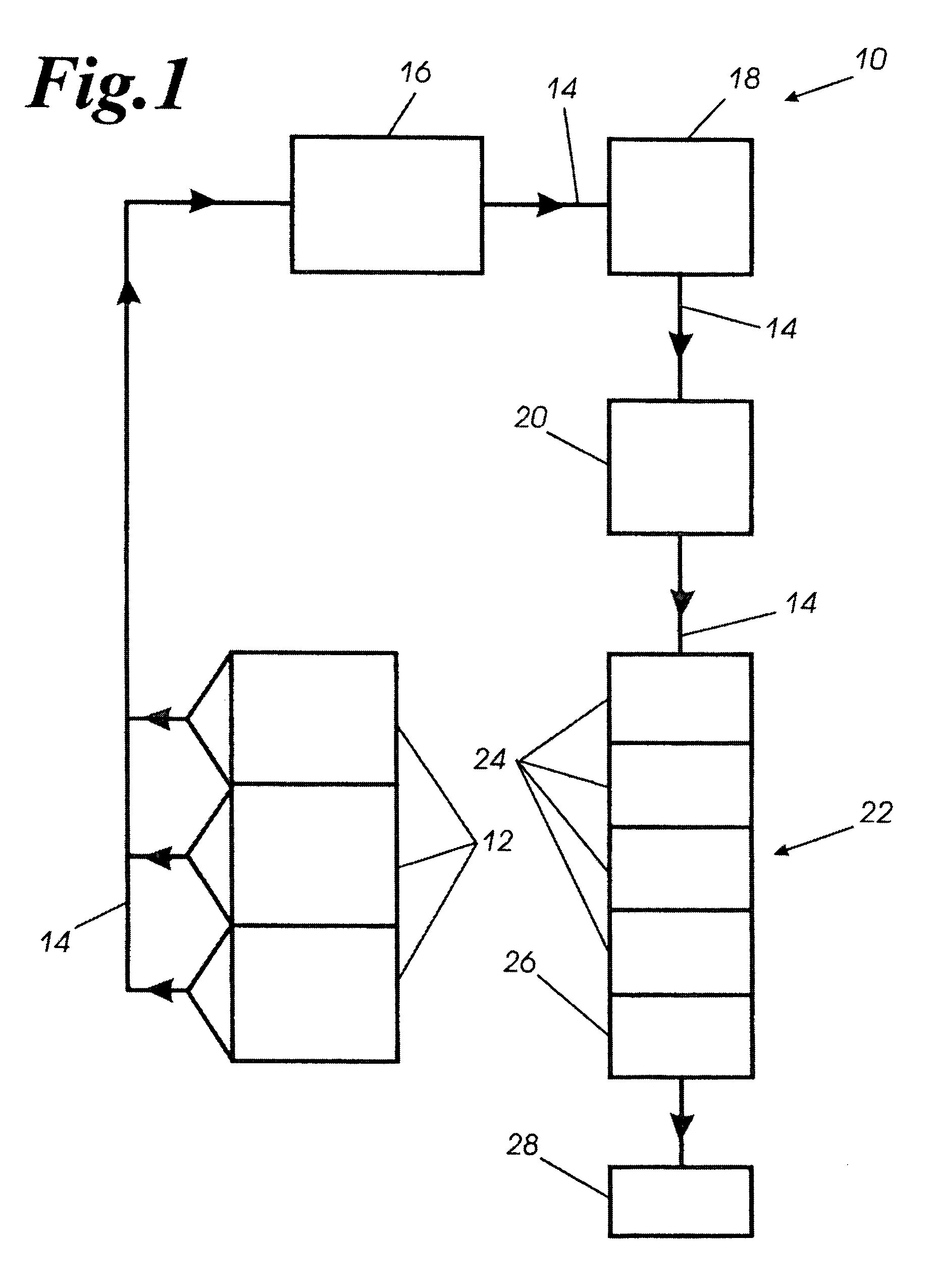Method of making high loft nonwoven
a non-woven, high-loft technology, applied in the field of high-loft, can solve the problems of high initial loft of the fabric, limited conventional process, and high cross-direction tensile strength of the web, and achieve the effects of improving strength, improving fire retardancy, and balanced strength properties in machine and cross-direction
- Summary
- Abstract
- Description
- Claims
- Application Information
AI Technical Summary
Benefits of technology
Problems solved by technology
Method used
Image
Examples
example 1
[0045] Referring to Table 1, the quality of a Control high loft nonwoven fabric and three Sample fabrics are compared. Each of the fabrics had a weight of 0.75 oz / ft2 and a weight percent blend of: 20% 4 dpf (denier per filament) low melt binder fiber, 30% 25 dpf PET, and 50% 15 dpf PET. The Samples were processed with different number of layers, with the Control, First Sample, Second Sample and Third Sample respectively having 2, 2, 3 and 4 layers. In order to maintain the same weight (oz / ft2), the process rate was adjusted, with the Control, First Sample, Second Sample, and Third Sample respectively processed at 1278 lbs / hr, 1775 lbs / hr, 1896 lbs / hr and 1896 lbs / hr.
TABLE 1Percent Loft Recovery for 0.75 oz / ft2 Control and SamplesApplied Load (lbs)Loft (inches)Percent Loft (%)ControlBlend (20% 4 dpf low melt, 30% 25 dpf PET, and 50% 15 dpf PET)Rate: 1278 lbs / hr Weight: 0.75 oz / ft2 Number of Laps: 2Zero1.75100 51.3979.4101.1867.4151.0358.9200.9353.1Load removed1.6896.0(% loft rec...
example 2
[0049] Referring to Table 3, a Control high loft, nonwoven fabric and two Sample fabrics are compared wherein each of the fabrics had a weight of 1.0 oz / ft2 and a weight percent blend of: 20% 4 dpf low melt binder fiber, 30% 25 dpf PET, and 50% 15 dpf PET. The Samples were processed with different number of laps, with the Control, First Sample and Second Sample having 3, 3 and 4 laps, respectively. The process rate was adjusted in order to maintain the same weight (oz / ft2), with the Control, First Sample and Second Sample respectively processed at 920 lbs / hr, 1050 lbs / hr and 1100 lbs / hr.
TABLE 3Percent Loft Recovery for 1.0 oz / ft2 Control and SamplesApplied Load (lbs)Loft (inches)Percent Loft (%)ControlBlend (20% 4 dpf low melt, 30% 25 dpf PET, and 50% 15 dpf PET)Rate: 920 lbs / hr Weight: 1.0 oz / ft2 Number of Laps: 3Zero2.82100 52.1475.9101.7562.1151.4350.7201.346.1Sample 1Blend (20% 4 dpf low melt, 30% 25 dpf PET, and 50% 15 dpf PET)Rate: 1050 lbs / hr Weight: 1.0 oz / ft2 Number o...
example 3
[0053] Because the drafter provides a more balanced fabric (with respect to certain physical properties), it is possible to lower the amount of binder and still achieve good tensile strength properties. Table 5 compares the Control having 20% binder and the Samples each of which had a weight of 1.0 oz / ft2 and a weight percent blend of: 10% 4 dpf low melt binder fiber, 35% 25 dpf PET, and 55% 15 dpf PET.
TABLE 5Loft Recovery for 1.0 oz / ft2 Control and 10% Low Melt Binder FiberSamplesApplied Load (lbs)Loft (inches)Percent Loft (%)ControlBlend (20% 4 dpf low melt, 30% 25 dpf PET, and 50% 15 dpf PET)Rate: 920 lbs / hr Weight: 1.0 oz / ft2 Number of Laps: 3Zero2.82100 52.1475.9101.7562.1151.4350.7201.346.1Load removed2.795.7(% loft recovery)Sample 1 (10% Low melt fiber)Blend (10% 4 dpf low melt, 35% 25 dpf PET, and 55% 15 dpf PET)Rate: 1050 lbs / hr Weight: 1.0 oz / ft2 Number of Laps: 3Zero2.41100 51.7673.0101.4359.3151.2551.9201.1146.1Load removed2.2593.4(% loft recovery)Sample 2 (10% Low...
PUM
| Property | Measurement | Unit |
|---|---|---|
| low melt | aaaaa | aaaaa |
| temperature | aaaaa | aaaaa |
| weight | aaaaa | aaaaa |
Abstract
Description
Claims
Application Information
 Login to View More
Login to View More - R&D
- Intellectual Property
- Life Sciences
- Materials
- Tech Scout
- Unparalleled Data Quality
- Higher Quality Content
- 60% Fewer Hallucinations
Browse by: Latest US Patents, China's latest patents, Technical Efficacy Thesaurus, Application Domain, Technology Topic, Popular Technical Reports.
© 2025 PatSnap. All rights reserved.Legal|Privacy policy|Modern Slavery Act Transparency Statement|Sitemap|About US| Contact US: help@patsnap.com


